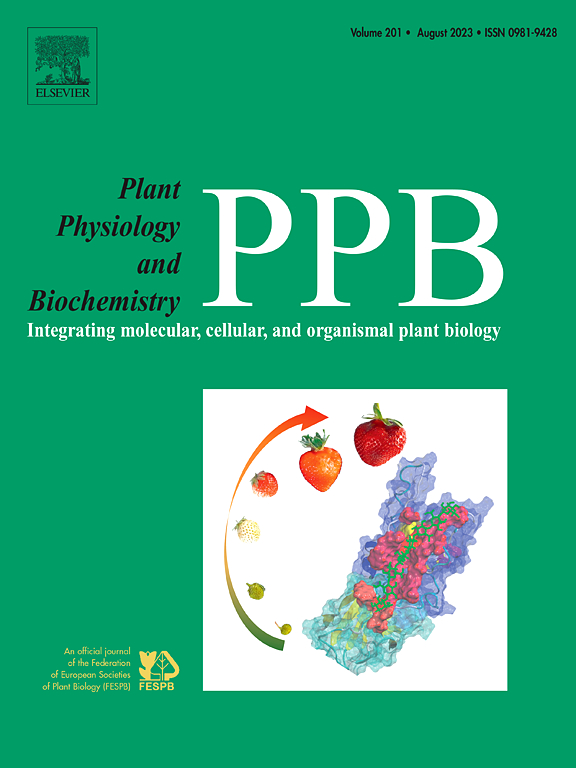The study on the function of exogenous NO-mediated miR166e-5p in regulating the drought resistance of alfalfa
IF 5.7
2区 生物学
Q1 PLANT SCIENCES
引用次数: 0
Abstract
The "king of forage," alfalfa (Medicago sativa L.), is not only a high-quality forage crop but also addresses challenges arising in agricultural production and environmental governance. However, its production and application are severely impacted by drought. Physiological phenotype analysis has revealed that exogenous nitric oxide (NO) can enhance the drought tolerance of alfalfa. This study utilizes "Sandeli" alfalfa as the material to investigate the function of exogenous nitric oxide (NO)-mediated miR166 in regulating drought tolerance in alfalfa through the application of AmiRNA (Artificial microRNA) technology and STTM (Short Tandem Target Mimic) technology. The regulation of drought resistance in miR166-transformed alfalfa by exogenous nitric oxide (NO) indicates that silencing miR166e-5p leads to the serration of alfalfa leaf margins and delayed wilting in detached leaves. The content of proline, an osmoregulatory substance, increases to 1.58 times that of the wild type. The activities of antioxidant enzymes increase to 1.39 to 1.59 times those of the wild type, while the contents of H2O2 (Hydrogen Peroxide) and MDA (Malondialdehyde) decrease to 61 % and 72 % of the wild type, respectively. Additionally, the expression of target genes and NO synthase genes is upregulated, with the NR2 gene showing a 2.27-fold upregulation. Overexpression of miR166e-5p exacerbates the damage to the antioxidant system and reduces osmoregulatory substances. In summary, silencing miR166e-5p enhances the drought tolerance of alfalfa. The application of exogenous NO causes the physiological indicators and gene expression levels in the overexpressing lines to trend towards those of the wild type, effectively reducing the drought sensitivity caused by miR166e-5p overexpression. This study screens out miR166-5p related to drought tolerance, laying a theoretical foundation for the rapid breeding of drought-tolerant alfalfa.
外源no介导的miR166e-5p在苜蓿抗旱性调控中的作用研究
“饲料之王”苜蓿(Medicago sativa L.)不仅是一种优质的饲料作物,而且还解决了农业生产和环境治理中出现的挑战。然而,干旱严重影响了其生产和应用。生理表型分析表明,外源一氧化氮(NO)能增强紫花苜蓿的耐旱性。本研究以“Sandeli”紫花苜蓿为材料,应用AmiRNA (Artificial microRNA)技术和STTM (Short Tandem Target Mimic)技术,研究外源一氧化氮(NO)介导的miR166在紫花苜蓿抗旱性调控中的作用。外源一氧化氮(NO)对mir166转化的紫花苜蓿抗旱性的调控表明,沉默miR166e-5p导致紫花苜蓿叶缘呈锯齿状,离体叶片延迟萎蔫。渗透调节物质脯氨酸的含量是野生型的1.58倍。抗氧化酶活性提高到野生型的1.39 ~ 1.59倍,过氧化氢(H2O2)和丙二醛(MDA)含量分别下降到野生型的61%和72%。靶基因和NO合成酶基因表达上调,其中NR2基因表达上调2.27倍。miR166e-5p的过表达加剧了抗氧化系统的损伤,减少了渗透调节物质。综上所述,沉默miR166e-5p可提高紫花苜蓿的耐旱性。外源NO的施用使过表达系的生理指标和基因表达水平向野生型趋近,有效降低了miR166e-5p过表达引起的干旱敏感性。本研究筛选出与耐旱相关的miR166-5p,为快速选育耐旱苜蓿奠定理论基础。
本文章由计算机程序翻译,如有差异,请以英文原文为准。
求助全文
约1分钟内获得全文
求助全文
来源期刊
CiteScore
11.10
自引率
3.10%
发文量
410
审稿时长
33 days
期刊介绍:
Plant Physiology and Biochemistry publishes original theoretical, experimental and technical contributions in the various fields of plant physiology (biochemistry, physiology, structure, genetics, plant-microbe interactions, etc.) at diverse levels of integration (molecular, subcellular, cellular, organ, whole plant, environmental). Opinions expressed in the journal are the sole responsibility of the authors and publication does not imply the editors'' agreement.
Manuscripts describing molecular-genetic and/or gene expression data that are not integrated with biochemical analysis and/or actual measurements of plant physiological processes are not suitable for PPB. Also "Omics" studies (transcriptomics, proteomics, metabolomics, etc.) reporting descriptive analysis without an element of functional validation assays, will not be considered. Similarly, applied agronomic or phytochemical studies that generate no new, fundamental insights in plant physiological and/or biochemical processes are not suitable for publication in PPB.
Plant Physiology and Biochemistry publishes several types of articles: Reviews, Papers and Short Papers. Articles for Reviews are either invited by the editor or proposed by the authors for the editor''s prior agreement. Reviews should not exceed 40 typewritten pages and Short Papers no more than approximately 8 typewritten pages. The fundamental character of Plant Physiology and Biochemistry remains that of a journal for original results.

 求助内容:
求助内容: 应助结果提醒方式:
应助结果提醒方式:


